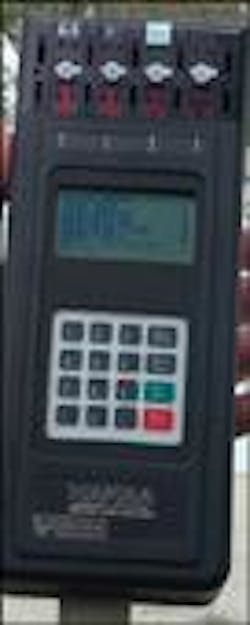Biodetectors give early warning of anthrax

Real-time detection of biological agents will be possible with the recent development of portable biological detectors built by Environmental Technologies Group (ETG; Baltimore, MD). Scientists at Lawrence Livermore National Lab (Livermore, CA) have spent decades developing germ detector technology to speed up detection and enable early warning of airborne biological agents. The component designs for performing and monitoring DNA detection on a hand-held device have been licensed to ETG from LLNL and Cepheid (Sunnyvale, CA).
The Hand-held Advanced Nucleic Acid Analyzer (HANAA) analyzes biological samples for the presence of certain DNA sequences found in pathogens such as anthrax or plague. Within minutes, emergency workers will be able to test four different samples for two different DNA sequences each, making HANAA the first truly portable, hand-held, real-time biodetection instrument. The system is ideal for applications in intelligence, combat, or emergency response, where early monitoring in the field can prevent widespread outbreak of a dangerous pathogen.
The HANAA instrument analyzes DNA using polymerase chain reaction (PCR) technology, a process of rapid heating and cooling that causes DNA to reproduce quickly. The HANAA system has a mini-fluorescence chambera silicon thermal cycler incorporating four excitation sources at different visible wavelength bands, and four silicon diode detectors. Among the sources are gallium nitride based blue light-emitting diodes (LEDs) and others that emit over a range of wavelengths. For example, the blue LEDs emit up to a wavelength of about 490 nm with a bandwidth of ±35-nm full-width half-maximum.
The chamber was developed at LLNL with microfabrication techniques derived from the semiconductor industry, resulting in a very small and efficient module. "Using blue LEDs for excitation was a recent breatkthrough for the development of the HANAA system, as well as the microfabrication technology that allows a chamber of silicon rather than metal," says Richard Langlois, senior biomedical scientist at LLNL.
At the core of the HANAA system is a flow cytometer, a device co-invented by Langlois in the 1970s. In flow cytometry, particles in a fluid are labeled with fluorescent dyes corresponding to different antibodies that bind to agents such as anthrax. Polymer beads flow through the chamber, past two lasers, a red laser diode and a green frequency-doubled Nd:YAG laser, which illuminate the particles. Any change in the intensity of the fluorescence flags the presence of biological agents that attach to the antibodies.
In addition to the hand-held first-response detector, a collaboration between LLNL and Los Alamos National Lab (Los Alamos, NM) has resulted in the deployment of a system capable of continuously monitoring the air and automatically analyzing samples for biological germs in large venues such as convention centers, stadiums, and airports. The Autonomous Pathogen Detection System (APDS), the size of a mail box or podium, is in the prototype stage of development.
"The APDS works like a silent burglar alarm," explains Langlois, "automatically reporting results to give early warning of harmful biological agents." The APDS requires suspicious pathogens to undergo a second DNA-based test to verify identification.
A similar but nonautomated system, the Biological Aerosol Sentry and Information System (BASIS) was part of the security network at the 2002 Winter Olympics in Salt Lake City, UT. The BASIS uses a network of sampling filters at various locations to capture aerosol samples that are tested in a mobile field laboratory. The system reduces testing time from days to hours, but requires many highly trained users. A system such as the APDS that continuously monitors and automatically reports results, however, could be available for commercialization by 2003 or 2004.
About the Author
Valerie Coffey-Rosich
Contributing Editor
Valerie Coffey-Rosich is a freelance science and technology writer and editor and a contributing editor for Laser Focus World; she previously served as an Associate Technical Editor (2000-2003) and a Senior Technical Editor (2007-2008) for Laser Focus World.
Valerie holds a BS in physics from the University of Nevada, Reno, and an MA in astronomy from Boston University. She specializes in editing and writing about optics, photonics, astronomy, and physics in academic, reference, and business-to-business publications. In addition to Laser Focus World, her work has appeared online and in print for clients such as the American Institute of Physics, American Heritage Dictionary, BioPhotonics, Encyclopedia Britannica, EuroPhotonics, the Optical Society of America, Photonics Focus, Photonics Spectra, Sky & Telescope, and many others. She is based in Palm Springs, California.
